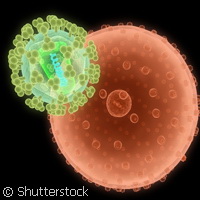Scientists launch new attack against AIDS
EU-funded researchers have developed a new defence against infection from the AIDS (acquired immune deficiency syndrome) virus. The pioneering method involves creating a protective shield that restricts the virus from making contact with a susceptible host cell and penetrating the immune system. Published in the journal Chemistry & Biology, the results pave the way for future pharmaceutical drugs that could combat the disease in its early stages. The three-year breakthrough study was led by Dr Félix Goñi of the Consejo Superior de Investigaciones Científicas (CSIC) in Spain, together with several CSIC departments and Spanish institutes specialising in chemistry and molecular biology. Their novel approach is based on the regulation of cell membrane fluidity in order to prevent the occurrence of 'membrane fusion', where contact is established between the cell membranes and the membrane of the AIDS virus. As the protective, fragile layer of the cytoplasm, the membrane of a cell has a similar structure to that of the AIDS virus membrane. Fusion occurs when both membranes make contact, thus producing an orifice that acts as an entry point for the virus. At this stage, the virus attaches to a cell receptor and begins to spread. The objective for Dr Goñi and his team was to make the membrane structure stronger and more rigid so as to prevent fusion from taking place altogether, and to avoid the subsequent viral escalation. Dr Goñi explained that in order for the orifice to be created, the membranes must be fluid and mobile. To counter this, the team discovered a procedure that makes the cell membranes tougher and less yielding. 'This [method] could well give rise to a new pharmaceutical drug, which makes the membranes more rigid and impede the entrance of the AIDS virus. Instead of the membrane being flexible, a kind of armour is established which makes the cell impenetrable,' Dr Goñi pointed out. Almost all existing methods to treat the AIDS virus focus on the need to stop the spread of the virus when it is already inside the first cell. An exception is Enfurvitide, a treatment that aims to stop the virus from entering the host cell but is based on a completely different principle to the one developed by Dr Goñi and his team. Beyond the AIDS virus, the strategy also has the potential to be applied to the flu virus and other viruses with membrane. The research was supported by two EU projects totalling EUR 21.89 million: CHAIN ('Collaborative HIV and anti-HIV drug resistance network'), and INNOCHEM ('Innovative chemokine-based therapeutic strategies for autoimmunity and chronic inflammation'). These projects were funded under the Health Theme of the Seventh Framework Programme (FP7) and the 'Life sciences, genomics and biotechnology for health' Thematic Area of the Sixth Framework Programme (FP6) respectively.
Countries
Spain



